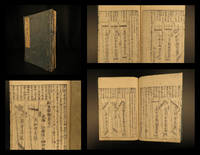
PHOTOGRAPH ALBUM OF 116 PROFESSIONAL IMAGES, MOSTLY FROM MIE-KEN, CIRCA 1895-1925, DURING THE MEIJI AND TAISHO PERIODS
de Japan, Honshu
- Usado
- very good
- First
- Estado
- Very Good
- Librería
-
Roosevelt, New Jersey, United States
Formas de pago aceptadas
Sobre este artículo
Reseñas
(¡Iniciar sesión or Crear una cuenta primero!)
Detalles
- Librería
- R & A Petrilla
(US)
- Inventario del vendedor #
- 037990
- Título
- PHOTOGRAPH ALBUM OF 116 PROFESSIONAL IMAGES, MOSTLY FROM MIE-KEN, CIRCA 1895-1925, DURING THE MEIJI AND TAISHO PERIODS
- Autor
- Japan, Honshu
- Estado del libro
- Usado - Very Good
- Cantidad disponible
- 1
- Edición
- Original photograph album
- Fecha de publicación
- 1925
- Palabras clave
- original photographs; culture; japan
- Catálogos del vendedor
- Ethnic Studies;
Términos de venta
R & A Petrilla
Orders are packed and shipped from our business offices in the village of Roosevelt, New Jersey, USA . Packages are dispatched as quickly and economically as we can manage, via the shipping method that you select
All items are guaranteed to be as described. Any item may be returned within ten (10) days of receipt if found to be other than as described. Please give us advance notice of any return. A returned item must reach us in the same condition as when we shipped it. Original binding, text block, bookplates and any inserted material must be intact.
Sobre el vendedor
R & A Petrilla
Sobre R & A Petrilla
Glosario
Algunos términos que podrían usarse en esta descripción incluyen:
- Gilt
- The decorative application of gold or gold coloring to a portion of a book on the spine, edges of the text block, or an inlay in...
- New
- A new book is a book previously not circulated to a buyer. Although a new book is typically free of any faults or defects, "new"...
- Poor
- A book with significant wear and faults. A poor condition book is still a reading copy with the full text still readable. Any...
- Leaves
- Very generally, "leaves" refers to the pages of a book, as in the common phrase, "loose-leaf pages." A leaf is a single sheet...
Preguntas frecuentes
Also Recommended
-

¡Ahorra un 10% en cada compra!
Únete al Biblioclub y empieza a ahorrar un 10% enn todas tus compras.
$29.95 / Año



